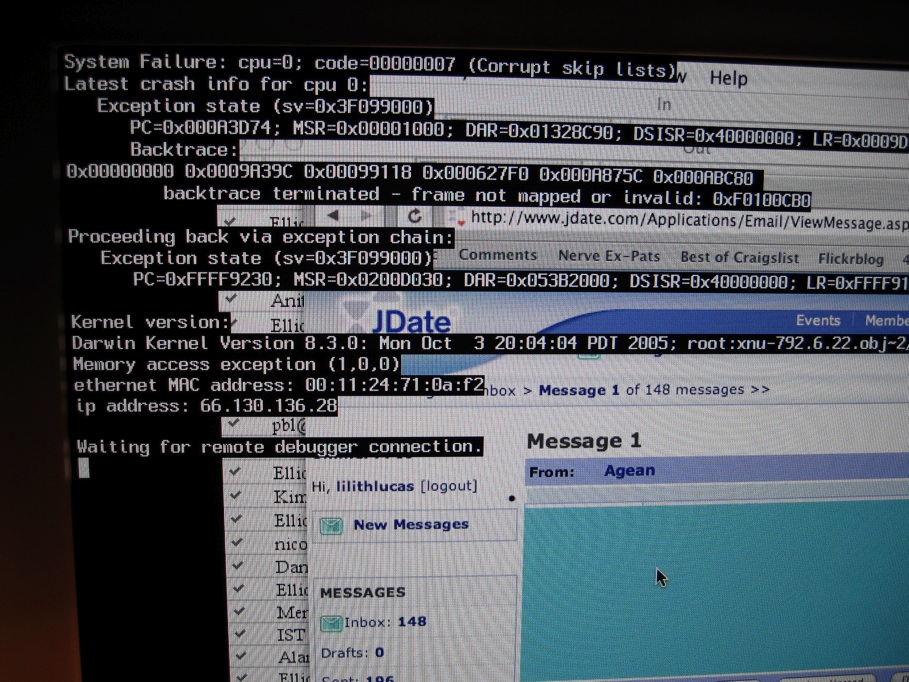|
Unix Wars
The Unix wars were struggles between vendors to set a standard for the Unix operating system in the late 1980s and early 1990s. Origins Although AT&T Corporation created Unix, by the 1980s, the University of California, Berkeley Computer Systems Research Group was the leading noncommercial Unix developer. In the mid-1980s, the three common versions of Unix were AT&T's System III, the basis of Microsoft's Xenix and the IBM-endorsed PC/IX, among others; AT&T's System V, which it sought to establish as the new Unix standard; and the Berkeley Software Distribution (BSD). All were derived from AT&T's Research Unix but had diverged considerably. Further, each vendor's version of Unix was different to some degree. For example, at a mid-1980s Usenix conference, many AT&T staff had buttons that read "System V: Consider it Standard" and a number of major vendors were promoting products based on System V. On the other hand, System V did not yet have TCP/IP networking built-in, and BSD 4 ... [...More Info...] [...Related Items...] OR: [Wikipedia] [Google] [Baidu] |
Unix Timeline
Unix (; trademarked as UNIX) is a family of multitasking, multiuser computer operating systems that derive from the original AT&T Unix, whose development started in 1969 at the Bell Labs research center by Ken Thompson, Dennis Ritchie, and others. Initially intended for use inside the Bell System, AT&T licensed Unix to outside parties in the late 1970s, leading to a variety of both academic and commercial Unix variants from vendors including University of California, Berkeley (BSD), Microsoft (Xenix), Sun Microsystems (SunOS/Solaris), HP/ HPE (HP-UX), and IBM (AIX). In the early 1990s, AT&T sold its rights in Unix to Novell, which then sold the UNIX trademark to The Open Group, an industry consortium founded in 1996. The Open Group allows the use of the mark for certified operating systems that comply with the Single UNIX Specification (SUS). Unix systems are characterized by a modular design that is sometimes called the "Unix philosophy". According to this philosophy, the ... [...More Info...] [...Related Items...] OR: [Wikipedia] [Google] [Baidu] |
Sun Microsystems
Sun Microsystems, Inc. (Sun for short) was an American technology company that sold computers, computer components, software, and information technology services and created the Java programming language, the Solaris operating system, ZFS, the Network File System (NFS), and SPARC microprocessors. Sun contributed significantly to the evolution of several key computing technologies, among them Unix, RISC processors, thin client computing, and virtualized computing. Notable Sun acquisitions include Cray Business Systems Division, Storagetek, and ''Innotek GmbH'', creators of VirtualBox. Sun was founded on February 24, 1982. At its height, the Sun headquarters were in Santa Clara, California (part of Silicon Valley), on the former west campus of the Agnews Developmental Center. Sun products included computer servers and workstations built on its own RISC-based SPARC processor architecture, as well as on x86-based AMD Opteron and Intel Xeon processors. Sun also developed its own ... [...More Info...] [...Related Items...] OR: [Wikipedia] [Google] [Baidu] |
Hewlett-Packard
The Hewlett-Packard Company, commonly shortened to Hewlett-Packard ( ) or HP, was an American multinational information technology company headquartered in Palo Alto, California. HP developed and provided a wide variety of hardware components, as well as software and related services to consumers, small and medium-sized businesses ( SMBs), and large enterprises, including customers in the government, health, and education sectors. The company was founded in a one-car garage in Palo Alto by Bill Hewlett and David Packard in 1939, and initially produced a line of electronic test and measurement equipment. The HP Garage at 367 Addison Avenue is now designated an official California Historical Landmark, and is marked with a plaque calling it the "Birthplace of 'Silicon Valley'". The company won its first big contract in 1938 to provide test and measurement instruments for Walt Disney's production of the animated film ''Fantasia'', which allowed Hewlett and Packard to formally esta ... [...More Info...] [...Related Items...] OR: [Wikipedia] [Google] [Baidu] |
Open Group
The Open Group is a global consortium that seeks to "enable the achievement of business objectives" by developing "open, vendor-neutral technology standards and certifications." It has over 840 member organizations and provides a number of services, including strategy, management, innovation and research, standards, certification, and test development. It was established in 1996 when X/Open merged with the Open Software Foundation. The Open Group is the certifying body for the UNIX trademark, and publishes the Single UNIX Specification technical standard, which extends the POSIX standards. The Open Group also develops and manages the TOGAF® standard, which is an industry standard enterprise architecture framework. Members The over 840 members include a range of technology vendors and buyers as well as government agencies, including, for example, Capgemini, Fujitsu, HPE, Orbus Software, IBM, Huawei, Philips, the U.S. Department of Defense, and NASA. There is no obligation on ... [...More Info...] [...Related Items...] OR: [Wikipedia] [Google] [Baidu] |
Novell
Novell, Inc. was an American software and services company headquartered in Provo, Utah, that existed from 1980 until 2014. Its most significant product was the multi-platform network operating system known as Novell NetWare. Under the leadership of chief executive Ray Noorda, NetWare became the dominant form of personal computer networking during the second half of the 1980s and first half of the 1990s. At its high point, NetWare had a 63 percent share of the market for network operating systems and by the early 1990s there were over half a million NetWare-based networks installed worldwide encompassing more than 50 million users. Novell technology contributed to the emergence of local area networks, which displaced the dominant mainframe computing model and changed computing worldwide. Novell was the second-largest maker of software for personal computers, trailing only Microsoft Corporation, and became instrumental in making Utah Valley a focus for technology and software ... [...More Info...] [...Related Items...] OR: [Wikipedia] [Google] [Baidu] |
Common Open Software Environment
The Common Open Software Environment (COSE) was an initiative formed in March 1993 by the major Unix vendors of the time to create open, unified operating system (OS) standards. Background The COSE process was established during a time when the "Unix wars" had become an impediment to the growth of Unix. Microsoft, already dominant on the corporate desktop, was beginning to make a bid for two Unix strongholds: technical workstations and the enterprise data center. In addition, Novell was seeing its NetWare installed base steadily eroding in favor of Microsoft-based networks; as part of a multi-faceted approach to battling Microsoft, they had turned to Unix as a weapon, having recently formed a Unix-related partnership with AT&T known as Univel. Unlike other Unix unification efforts that preceded it, COSE was notable in two ways: it was not formed in opposition to another set of Unix vendors, and it was more oriented toward making standards of existing technologies than creating ... [...More Info...] [...Related Items...] OR: [Wikipedia] [Google] [Baidu] |
POSIX
The Portable Operating System Interface (POSIX) is a family of standards specified by the IEEE Computer Society for maintaining compatibility between operating systems. POSIX defines both the system- and user-level application programming interfaces (APIs), along with command line shells and utility interfaces, for software compatibility (portability) with variants of Unix and other operating systems. POSIX is also a trademark of the IEEE. POSIX is intended to be used by both application and system developers. Name Originally, the name "POSIX" referred to IEEE Std 1003.1-1988, released in 1988. The family of POSIX standards is formally designated as IEEE 1003 and the ISO/IEC standard number is ISO/IEC 9945. The standards emerged from a project that began in 1984 building on work from related activity in the ''/usr/group'' association. Richard Stallman suggested the name ''POSIX'' (pronounced as ''pahz-icks,'' as in ''positive'', not as ''poh-six'') to the IEEE instead of former ... [...More Info...] [...Related Items...] OR: [Wikipedia] [Google] [Baidu] |
Communications Of The ACM
''Communications of the ACM'' is the monthly journal of the Association for Computing Machinery (ACM). It was established in 1958, with Saul Rosen as its first managing editor. It is sent to all ACM members. Articles are intended for readers with backgrounds in all areas of computer science and information systems. The focus is on the practical implications of advances in information technology and associated management issues; ACM also publishes a variety of more theoretical journals. The magazine straddles the boundary of a science magazine, trade magazine, and a scientific journal. While the content is subject to peer review, the articles published are often summaries of research that may also be published elsewhere. Material published must be accessible and relevant to a broad readership. From 1960 onward, ''CACM'' also published algorithms, expressed in ALGOL. The collection of algorithms later became known as the Collected Algorithms of the ACM. See also * ''Journal of the A ... [...More Info...] [...Related Items...] OR: [Wikipedia] [Google] [Baidu] |
Fuzz Testing
Fuzz may refer to: * Fuzz (film), ''Fuzz'' (film), a 1972 American comedy * ''Fuzz: When Nature Breaks the Law'', a nonfiction book by Mary Roach * The fuzz, a List of slang terms for police officers, slang term for police officers Music * Fuzz (electric guitar), distortion effects to create "warm" and "dirty" sounds * Fuzz (band), a garage rock band featuring Ty Segall, Charles Moothart and Chad Ubovich ** Fuzz (Fuzz album), ''Fuzz'' (Fuzz album), their 2013 debut studio album * The Fuzz (band), a 1970s American female vocal trio ** The Fuzz (album), ''The Fuzz'' (album), their 1970 debut album * Fuzz (Alice Donut album), ''Fuzz'' (Alice Donut album), 2006 punk album * Fuzz (Junkhouse album), ''Fuzz'' (Junkhouse album), 1996 rock album * "Fuzz", a 2007 song by Japanese rock band Mucc People * Fuzz White (1916–2003), Major League Baseball player * Calvin "Fuzz" Jones (1926–2010), American electric blues bassist and singer * Steve "Fuzz" Kmak (born 1970), American bassist who ... [...More Info...] [...Related Items...] OR: [Wikipedia] [Google] [Baidu] |
Crash (computing)
In computing, a crash, or system crash, occurs when a computer program such as a software application or an operating system stops functioning properly and exits. On some operating systems or individual applications, a crash reporting service will report the crash and any details relating to it (or give the user the option to do so), usually to the developer(s) of the application. If the program is a critical part of the operating system, the entire system may crash or hang, often resulting in a kernel panic or fatal system error. Most crashes are the result of a software bug. Typical causes include accessing invalid memory addresses, incorrect address values in the program counter, buffer overflow, overwriting a portion of the affected program code due to an earlier bug, executing invalid machine instructions (an illegal opcode), or triggering an unhandled exception. The original software bug that started this chain of events is typically considered to be the cause of the ... [...More Info...] [...Related Items...] OR: [Wikipedia] [Google] [Baidu] |



